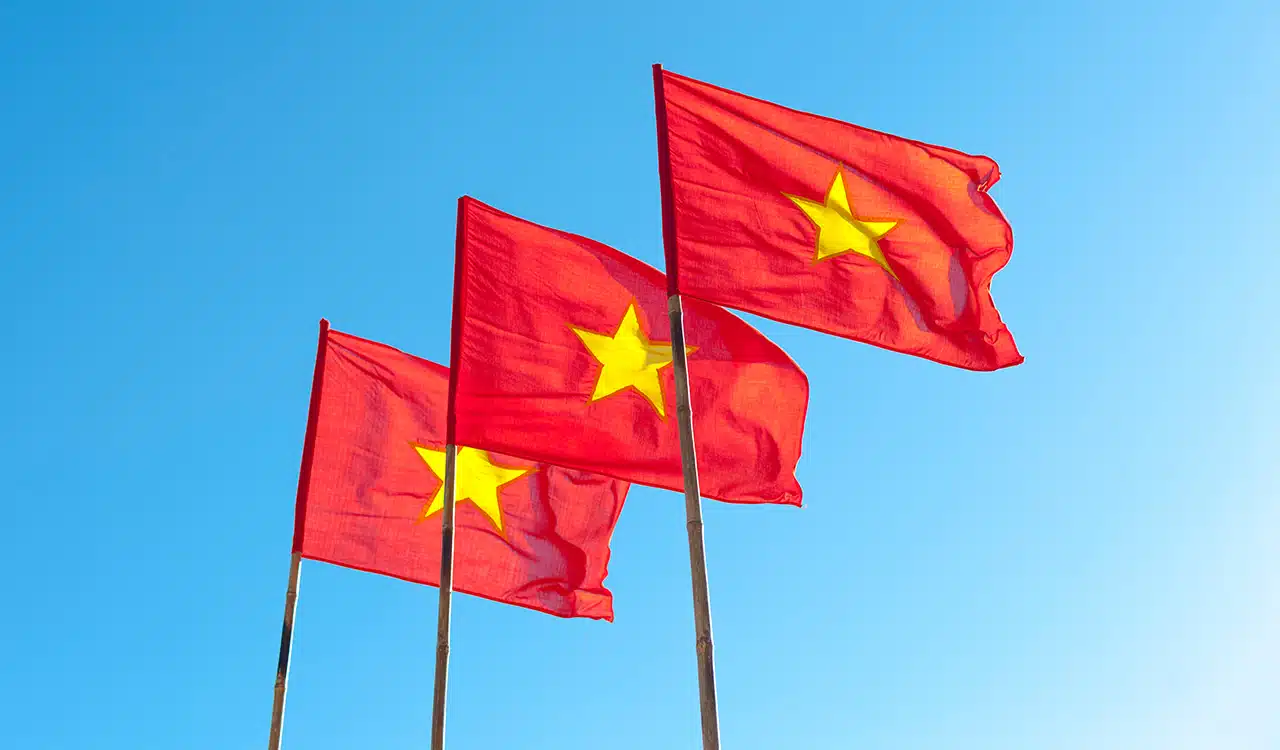Less than a month remains before the 90-day reprieve on Trump administration’s ‘Liberation Day’ reciprocal tariffs expire and the U.S. starts levying stiff duties on imports from nearly every country in the world. While Trump continues to lob the occasional bombshell—such as doubling steel and aluminum tariffs on June 3—America’s trading partners (and many American traders themselves) in recent weeks have grown more confident that the federal government’s interest in tariffs may be waning.
Another complication for Vietnam is that it is not particularly adept at aligning its interests with those of its trading partners. Despite being extremely dependent on exports and FDI for growth, Vietnam is inconveniently prickly and more than occasionally paranoid in its international relationships.
Proactive Vietnam
Vietnam, however, is taking no chances. The country has taken many steps to ingratiate itself with U.S. negotiators, such as preemptive announcements to reduce tariffs on U.S. imports and pledges to purchase more from America, including buying more liquified natural gas (LNG), cars and planes, and even Elon Musk’s StarLink satellite internet service. The Vietnamese government has also pushed through approvals clearing the way for the Trump family to build a $1.5 billion golf resort outside of Hanoi and a skyscraper in Ho Chin Minh City, even though it seemingly flouts its own foreign investment laws.
The stakes are high: Vietnam’s booming economy and incredibly robust domestic retail sector have been fuelled by fast-rising wages provided by its growing export-oriented contract manufacturing sector. Exports to the U.S. have roughly doubled in value over the last five years, reaching nearly $137 billion in 2024. America accounts for nearly a third of Vietnam’s total exports, largely consumer electronics, apparel, footwear, and furniture.
Smartphone makers, mostly South Korean and Chinese, produced more than 192 million units last year in Vietnamese factories, more than 15 percent of the world’s output. Vietnam has over 2,200 footwear manufacturing businesses, supplying 10 percent of the world’s shoes, making it the second-largest producer—and over 40 percent of that output goes to North America. Vietnam overtook China two years ago as the largest furniture supplier to the U.S., with $9.7 billion in imports in 2024.
America’s Favorite ‘Plus One’ Is Nonplussed
Vietnam’s rapid export growth is in large part because it has become U.S. retailers’ preferred “China Plus One” sourcing destination. For many years American buyers have diversified their supplier base away from China to reduce overdependence on a country that has become both more expensive and a political liability. Ironically, Vietnam has been one of the most attractive ‘plus one’ alternatives because its economy is the most China-like: tightly managed by a centralized government that has been keen to use its large, well-educated and relatively cost-effective workforce to push exports and propel development. As a result, foreign manufacturers have flocked to Vietnam, conservatively pouring between $150 and $200 billion into factories since 1990.
Now in a further ironic twist of fate, Vietnam stands to be punished by its biggest customer for being so successful as a supplier. In Donald Trump’s reductionist (and economically inaccurate) tariff calculus, any country which exports more to the U.S. than it imports is ‘cheating’ America, and needs to be taxed in proportion to the scale of their cheating. This is bad news for Vietnam which had a trade deficit with the U.S. of US$123.5 billion in 2024; only China’s and Mexico’s are higher.
By Trump’s calculations, this works out to a whopping 46 percent reciprocal tariff looming over Vietnam’s future exports. This is putting extreme pressure on the country’s policymakers to take on more imports to balance the trade deficit scales and find other ways to convince the U.S. to give it a break. But these tariffs will also put pressure on the U.S. companies that have become increasingly reliant on Vietnam to keep their costs—and their China risk—down.
Playing the China Card, Carefully
In addition to golf courses and skyscrapers, Vietnam is also trying to show the Trump administration the value of its friendship by helping out in its long-running trade war with China. Vietnam has pledged to crack down on ‘transshipment fraud’ of Chinese goods rerouted through Vietnam to evade U.S. tariffs. The port of Hai Phong has long been suspected of serving as a transshipment hub for Chinese exports, which is only a few hours’ drive from the 800-mile-long border the two countries share.
However, Vietnam cannot afford to be too aggressive in helping the U.S. contain China. Similar to South Korea and many other Asian producers, Vietnam has a vital, interdependent and uneasy trading relationship with China. China is a primary investor in Vietnam’s manufacturing sector, and a source of most of the chemicals, textiles and digital components used in the goods Vietnam uses to assemble products shipped to the U.S. China’s President Xi Jinping visited Vietnam in April (his second trip in less than two years) as part of his post-Liberation Day charm offensive tour to Southeast Asia which included stops in Malaysia and Cambodia, to show China’s continued support for its important manufacturing and trade partners in the region. All this complicates Vietnam’s ability to make a deal with the U.S.
Ambivalent Global Citizen
Another complication for Vietnam is that it has trouble aligning its interests with those of the rest of the world. Despite being extremely dependent on exports and FDI for growth, Vietnam is inconveniently prickly and more than occasionally paranoid in its international relationships.
Vietnam continues to be one of the world’s most restrictive internet economies: Freedom House ranked the country the 5th lowest on its global Internet Freedom Index. On Christmas day last year, the government enacted Decree 147, a severely restrictive new internet usage law that limits the amount of time citizens can play online games and requires foreign social media companies to host their user data in the country and provide it to authorities, on demand. Vietnam’s iron grip over internet access certainly makes the StarLink agreement look oddly permissive. Vietnam is also near the bottom (173 out of 180 countries) in the Reporters Without Borders Press Freedom Index. A recent issue of The Economist which featured a cover story on Vietnam and its leader To Lam was banned in Vietnam, even though it was only marginally critical of To and his government’s economic reform efforts.
Digital Isolationist
These restrictions make Vietnam look more like the hermit kingdom of North Korea instead of globalist Singapore. This may explain the lack of nuance in Vietnam’s international engagement strategies, such as the brash offers of golf courses and satellite deals to curry favor with America. But more importantly for the future of its economy, throttling internet access limits the flow of ideas and innovation in and out of Vietnam. This in turn will stymie many higher-value industry sectors that the government hopes will eventually transform its economy, such as its surging ecommerce industry, thought to have generated $36 billion in value last year.
Despite, or rather because of, the great success of Vietnam’s export-fuelled growth, it is facing the same ‘middle-income trap’ problem as China and South Korea (Vietnam’s de facto economic role models). As incomes continue to rise—like many export-driven nations, wages in Vietnam have more than doubled over the last dozen years—the country is becoming a less attractive place to assemble finished goods. This means an economic upgrade is needed.
Lack of Champions
Most of Vietnam’s export-driven peers have tried to build up national champions that can both serve the growing needs of their local consumers and eventually begin to start to export products and services to move up the value chain. But Vietnam is still relatively stuck, with its domestic retail economy swamped with international brands. While there are some rising domestic stars, there are few national champions outside of a few FMCG or agribusiness brands.
Vietnam still lacks high-end manufacturing design capabilities (as China and South Korea have), a ‘self-sustaining’ domestic retail economy (like China), or increasingly world-class brands (like South Korea). This means that even if Trump’s tariffs go through (which looks increasingly unlikely in these TACO times), Vietnam will struggle to sustain its growth without a significant shift in its economy. Its domestic consumer markets will also suffer and falter if Vietnam fails to find a path towards higher-value exports, and starts to loosen its iron grip over its digital economy.
In both tariff-on and tariff-off (or -delayed) scenarios, Vietnam’s future also presents risks for U.S. companies. For decades, Vietnam has been a willing and able partner for U.S. brands looking for a substitute for China’s efficient and cost-effective production—like Nike, which produced more than half of its sports shoes and a quarter of its clothing in Vietnamese factories last year.
Tariffs will erode Vietnam’s cost advantages for Nike and other brands nearly instantly. Other footwear and apparel production centers in Southeast Asia will share Vietnam’s fate (Cambodia and Laos are facing similar tariff levels), which will make it difficult for brands to shift manufacturing to avoid these costs. If tariffs do not come to pass, however, Vietnam will still also lose its cost advantage, albeit more slowly, to good old-fashioned wage increases as it continues its rapid ascent to becoming a middle-income country.
In either case, this is a clarion call for Vietnam, its manufacturing partners in the U.S., and elsewhere to take on higher-value-added links in the production chain. Despite concerns about China and its competence in managing increasingly dispersed global supply chains, U.S. brands and others will have work with Vietnamese manufacturers to become more China-like. This means increasing investments in process automation and design in Vietnam while finding ways to export Vietnamese assembly capabilities to other, cheaper countries. In some ways, the threat of tariffs could serve as a catalyst for one of America’s most faithful trade partners to accelerate its own much-needed economic transformation.





